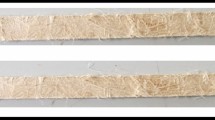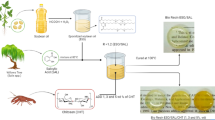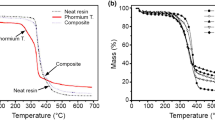Abstract
The current investigation reports the use of a residue from the iron metallurgy namely, “slag” to produce unsaturated polyester composite material-based slag (UPES). The slag has been mechanically treated by crushing and milling prior incorporating in the polymer. The role of the slag as co-curing agent of the polymerization reaction is studied under isothermal and dynamic conditions using differential scanning calorimeter (DSC); consequently, the role of the slag to enhance the thermal stability as well as the heat storage capacity of the UPE is reported. The isothermal cure temperature was varied from 80 to 120 °C, whereas the dynamic scan was run from room temperature to 250 °C at constant heating rate. This allowed us to estimate the degree of cure and cure rate. It has been found that incomplete cure was recorded by DSC for the pristine sample due to vitrification phenomenon. On the other hand, the sample with the slag displayed complete cure at 120 °C indicating that the heat storage capability of the polymer has been improved. The thermal stability of the samples was evaluated by a thermogravimetric analyzer coupled with a DSC unit. The sample containing slag responded better against thermal stimulation which was related to the mineral nature of the slag and the polar–polar interactions between the slag and the matrix. The interactions were attributed to the switch from hydroxyl–hydroxyl interactions to the formation of hydroxyl–slag (oxide). The interactions between the slag and the UPE resin were inspected using attenuated total reflectance infrared spectroscopy. The response of the samples to dynamic stimulation was evaluated by a dynamic mechanical analyzer. The sample containing slag displayed higher elastic moduli and broader tan (α) indicating better damping.








Similar content being viewed by others
References
Andjelkovic D, Culkin A, Loza R (2009) Unsaturated polyester resins derived from renewable resources. Composites & Poltcon, American Composites Manufactures Association, January 15–17, 2009
Shenoy A, Melo D (2007) Evaluation of mechanical properties of unsaturated polyester-guar gum/hydoxypropyl guar gum composites. eXPRESS Polym Lett 1:622–628
Sinha R (2000) Outlines of polymer technology. Prentice-Hall, New Delhi
Nurazzi NM, Khalina A, Sapuan SM, Laila AM, Rahmah M (2017) Curing behaviour of unsaturated polyester resin and interfacial shear stress of sugar palm fibre. J Mech Eng Sci 11(2):2650–2564. https://doi.org/10.15282/jmes.11.2.2017.8.0242.
Zhang W, Li X, Jiang Y, Yang R (2013) Investigations of epoxy resins flame-retarded by phenyl silsesquioxanes of cage and ladder structures. Polym Degrad Stab 98:246–254
Kuang W, Richardson AA (2007) New amine promoter for low temperature cures of MEKP initiator unsaturated polyester resin systems. Compos Res J 1(4):9–13
Li Z, Yang R (2015) Flame retardancy, thermal and mechanical properties of sulfonate-containing polyhedraloligomeric silsesquioxane (S-POSS)/polycarbonate composites. Polym Degrad Stab 116:81–87
Mohd Nurazzi N, Khalina A, Sapuan SM, Dayang Laila AHAM, Rahmah M, Hanafee Z (2017) A review: fibres, polymer matrices and composites. Pertanika J Sci Technol 25:1085–1102
Osman EA, Vakhguelt A, Sbarski I, Mutasher S (2012) Curing behavior and tensile properties of unsaturated polyester containing various tyrene concentrations. Malays Polym J 7(2):46–55
Mousa A, Karger-Kocsis J (2000) Cure characteristics of a vinylester resin as assessed by FTIR and DSC techniques. Polym Polym Compos 8(7):455
Rodriguez EL (1991) The effect of free radical initiators and fillers on the cure of unsaturated polyester resins. Polym Eng Sci 31:41022
Gunes I, Uygunoglu T, Evcin A, Ersoy B (2017) Investigation of wear strength of blast furnace slag blended polymer materials. Acta Phys Polym A 132:599
Pradeep AV (2015) Effect of blast furnace slag on mechanical properties of glass fiber polymer composites. Proc Mater Sci 10:230
Qiu X, Wirges W, Gerhard R, Ren M, Tefferi M, Cao Y (2016) Presented at the IEEE international conference on high voltage engineering and application (ICHVE), Chengdu, China
Dua S, McCullough RL, Palmese GR (1999) Copolymerization kinetics of styrene/vinyl-ester systms: low temperature reactions. Polym Comput 20:379
Kuos W, Lin H-C, Huang W-J, Huang C-F, Chang F-C (2006) J Polym Sci 44:673–686
Mousa A, Heinrich G, Wagenknecht U (2017) Toughened unsaturated polyester composites reinforced with slag material. Polym Plast Technol Eng 56:1657–1664
Mousa A (2013) The effect of feldspar and kaolin on mechanical performance of SBR/LDPE composites. Int J Ind Chem 4:26
Bastiurea M, Rodeanu MS, Andrei G, Dima D, Murarescu M, Ripa M, Circiumaru A (2014) Determination of specific heat of polyester composite with graphene and graphite by differential scanning calorimetry. Tribol Ind 36(4):419–427
Bautista Y, Gozalbo A, Mestre S, Sanz V (2018) Thermal degradation mechanism of a thermostable polyester stabilized with an open-cage oligomeric silsesquioxane. Materials 11:22. https://doi.org/10.3390/ma11010022
Acknowledgements
Ahmad Mousa is pleased to acknowledge the financial support received by to the Leibniz-Institut für Polymerforschung, Dresden e.V. for allowing a researcher stay to carry out the current research and to al-Balqa Applied University-Jordan for the sabbatical leave. The authors are also pleased to thank Büfa-Germany for providing the Palatal® P 61-01.
Author information
Authors and Affiliations
Corresponding author
Ethics declarations
Conflict of interest
On behalf of all the authors, the corresponding author declares that there are no conflicts of interest to disclose.
Additional information
The contributing editor for this article was João António Labrincha Batista.
Publisher's Note
Springer Nature remains neutral with regard to jurisdictional claims in published maps and institutional affiliations.
Rights and permissions
About this article
Cite this article
Mousa, A., Wagenknecht, U., Gedan-Smolka, M. et al. Cure Characteristics and Thermal Behavior of Organic–Inorganic Hybrid Composite as Assessed by DSC, TGA, and DMA Techniques. J. Sustain. Metall. 5, 442–448 (2019). https://doi.org/10.1007/s40831-019-00234-w
Published:
Issue Date:
DOI: https://doi.org/10.1007/s40831-019-00234-w




